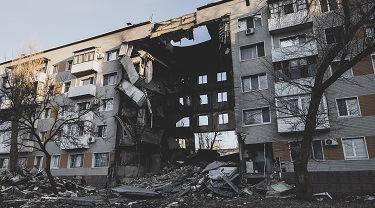Geopolitical uncertainty has always been a concern for Canadian exporters doing business abroad. But the escalation and broadening of tensions across regions has increased global instability to levels not seen in at least 50 years. How can businesses measure and convert these risks into costs that help better inform decision-making?
Notwithstanding recent panda diplomacy efforts, U.S.-China tensions have led to confrontation in key strategic industries, simmering tensions in the South China Sea, and duelling charm offensives across the fast-growing markets of Southeast Asia. What’s more, the world is now dealing with two hot wars blazing in strategically significant parts of the world. And, since 2020, there have been eight military coups in West and Central Africa, compared to less than one per year in the preceding decade.
Aside from the threat of direct military engagement, leadership changes and policy instability can also impact the cost of doing business. An increasingly intensifying global cost-of-living crisis has contributed to the success of populist-brand politicians and political extremism on every continent, except Australia and Antarctica. Next year, 76 countries—accounting for more than half of the world’s population—are scheduled to send voters to the ballot boxes, raising the spectre of increased protectionism.
In the United States, the seemingly irreconcilable polarization of political discourse seems to have that country careening toward a rematch of its “most important election in history.” A second-term Trump administration would almost certainly come with increased uncertainty over co-operation in areas, like security, trade, technology and climate change. Meanwhile, the world continues to confront evolving generational challenges, like the demographic shifts hampering our ability to keep up with our ever-increasing needs, society’s inability to accommodate exponential technological innovation, and our existential climate-change countdown.
You should also check out
Get the answers you need to make informed business decisions
So, how can businesses quantify these risks? In the past, the market provided cognitive shortcuts to help measure global risks and their cost on business such as the Chicago Board Options Exchange Volatility Index (VIX) or even the price of key commodities, like oil. But at the time of writing, the VIX was hovering around 14, well-below its historical average. West Texas Intermediate (WTI) crude, meanwhile, was sitting comfortably south of its psychological threshold, of $100 per barrel. Did the COVID-19 virus also cause the market to lose its sense of smell?
Some point to the fact that indicators such as the VIX simply tell us where money is flowing at a point in time. Others point to the increasing use of alternate financial instruments to trade on market volatility such as zero-day to expiration options. When it comes to commodities, we need to remember that pricing has both a supply and demand component. While oil prices hiccupped immediately following the Oct. 7 Hamas attacks on Israel, concerns around weak global demand—in the context of healthy stockpiles—continue to weigh on valuations.
So, how can exporters measure the true costs of geopolitical events on their business? As highlighted in EDC Economics’ latest Country Risk Quarterly, one method is through credit risk ratings assigned to sovereign obligors and commercial country credit ceilings. Bond spreads can further assist in assessing country risk. Spreads indicate the additional return demanded by investors for assuming direct exposure to a sovereign or commercial entity, domiciled in a particular market over the perceived “risk-free” return of U.S. Treasuries. Spreads tend to react sharply to material economic developments, but also track geopolitical events with equal precision.
As Russian troops amassed along the Ukrainian border in 2021, Ukraine’s bond spreads gradually increased. On Feb. 24, 2022, when Russia officially breached Ukrainian territory, Ukraine’s spreads doubled overnight. More recently, following the Hamas attacks, the spreads of neighbouring countries shot up, on fears of a broader regional conflict. As higher spreads drive up the cost of capital, payment capacity is reduced further, in what often sets off a vicious cycle of deteriorating business conditions.
So, what are these signals telling us? Well, consider first that of the once-electrifying BRICS (Brazil, Russia, India, China, and South Africa) nations, only China remains an investment-grade country. As expected, all emerging market regions have seen an increase in bond spreads on pre-2020 levels, with emerging Europe and Africa widening the most. At the country level, countries such as Ecuador, Kenya, Lebanon, Pakistan, and Poland, among others, have seen notable increases.
The bottom line?
EDC Economics believes that geopolitical risk will likely further intensify in 2024—and beyond—with fighting in Ukraine and Israel expected to continue through next year. An historic number of elections, amid growing international tensions and increasing domestic unrest, will only add to the uncertainty.
At the same time, the U.S.-China dynamic will remain a challenge, and the flow of goods and services across borders has become more difficult to manage. With many of these issues likely to linger, Canadian exporters looking to pursue growth strategies in non-traditional markets need to be aware that this will come at an additional cost. Fortunately, EDC’s country risk expertise is here to help.
This week, special thanks to Richard Schuster, senior economist in the EDC Economics department.
As always, at EDC Economics, we value your feedback. If you have ideas for topics that you’d like us to explore, please email us at economics@edc.ca and we’ll do our best to cover them.
This commentary is presented for informational purposes only. It’s not intended to be a comprehensive or detailed statement on any subject and no representations or warranties, express or implied, are made as to its accuracy, timeliness or completeness. Nothing in this commentary is intended to provide financial, legal, accounting or tax advice nor should it be relied upon. EDC nor the author is liable whatsoever for any loss or damage caused by, or resulting from, any use of or any inaccuracies, errors or omissions in the information provided.






